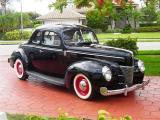|
|||||||
| Sponsored Links (Register now to hide all advertisements) |
|
|
 |

|
Thread Tools | Display Modes |
|
|
#21 |
|
Senior Member
Join Date: May 2013
Location: kent , u.k
Posts: 519
|
Barry I forgot to add I have since put in a 3 piece multi reducer ,thanks
|
|
|

|
|
|
#22 |
|
Junior Member
Join Date: Jul 2014
Posts: 3
|
Thanks to all for your input about my dash gauges not working. I think I can figure it all out now that all you experts have chimed in. I'm thinking about changing motors, one with no coil. Do any of you have experience on wiring with an alternator but eliminating the starter relay and the coil?
Electric wiring just ain't my thing. Dutch |
|
|

|
| Sponsored Links (Register now to hide all advertisements) |
|
|
|
|
#23 |
|
Senior Member
Join Date: May 2010
Location: Coral Springs FL
Posts: 10,950
|
Dutch, I don't think there's a way to eliminate the starter relay (solenoid) and the coil.
|
|
|

|
|
|
#24 |
|
Member
Join Date: Mar 2015
Location: Portland Oregon
Posts: 86
|
A note on gauges: up to 1955, King Seely (KS) gauges were used exclusively by Ford and several other manufacturers. The KS gauge is a bi-metallic, thermally actuated gauge head. The amount of amperage flowing through the gauge warms the bi-metallic fulcrum, moving the pointer. This is regulated by the sending unit. Internal to the senders is a points regulating system. Based on the physical property being measured, the points system is moved either closer together or farther away. This distance alters the rate of points contact over time, this changing the average current over time. When referencing the 5 volt scenario, one is referring to the reduced average voltage over time, but really, all the gauges care about is current. In 1956, KS tooled up for 12 volt, so in 56' you have 12 volt only senders and gauges. As you 56' owners might know, they only used that system for one year, with a few leftover parts making their way onward into some trucks and such. In 57' KS decided to revamp their engineering, get away from the complicated senders and retain the older 6 volt gauge movements by externally regulating the voltage prior to the gauge and regulate the resistance to ground via "modern" type rheostatic sending units that they used up into the 80's. These are the same style sending units that you see manufactured today. So, for voltage conversion (don't put 12 volts to a 6 volt gauge, please!) one must decide if they will continue to use the original senders and simply knock the 12 volts down to 6 volt OR use modern sending units with the voltage knocked down to the nominal 5 volts that the original senders would have regulated as an average. We restore gauges professionally and in my humble opinion, if you are going 12 volts, you are wise to use modern sending units. They are more readily replaced and available in a variety of ranges. Save your originals for a friend building a 6 volt car. Feel free to contact us if you have any questions or clarifications: morrisgauge.com
|
|
|

|
 |
«
Previous Thread
|
Next Thread
»
|
|
| Sponsored Links (Register now to hide all advertisements) |
|
|
All times are GMT -5. The time now is 02:55 PM.




 Linear Mode
Linear Mode

